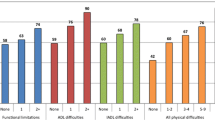Abstract
With advancing age and disability, continuing care retirement community (CCRC) residents relocate to the next care level as needed. Occasionally, independent living does not offer services a resident needs, yet the resident may not be ready for assisted living. Additionally, since research indicates relocation negatively impacts frail adults’ health/well-being (Bernard et al. 1996), it is reasonable to ask if this approach is optimal. Might aging in place within independent living be more beneficial? Research also shows satisfying social needs is increasingly important to supporting health (Glass et al. 2006) and life satisfaction (Jang et al. 2004) as we age. How then, do we design to support resident social interaction without necessitating relocation? As aging residents experience physical declines such as limited mobility, nearby space designs become increasingly important. This study involving south eastern US, CCRC residents sought to determine how aging in place might be supported by social space designs. Using the Successful Social Space Attribute Model (Campbell 2014) as its organizing framework, this study examined independent and assisted living resident perspectives to identify factors impacting how well social spaces were liked and used, the markers of social space success. For both groups, this study identified two factors: active engagement opportunities (i.e. ways to engage with the environment and other people), and home range (i.e. resident’s daily path of travel). These findings suggest guidelines for designing CCRC social spaces to support aging in place.



Similar content being viewed by others
References
Aquino, J., Russell, D., Cutrona, C., & Altmaier, E. (1996). Employment status, social support, and life satisfaction among the elderly. Journal of Counseling Psychology, 43(4), 480–489.
Bernard, A. M., Hayward, R. A., Rosevear, J., Chun, J., & McMahon, L. F. (1996). Comparing the hospitalizations of transfer and non-transfer patients in an academic medical center. Academic Medicine, 71, 262–266.
Brown, T., Kaplan, R., & Quaderer, G. (1999). Beyond accessibility: Preference for natural areas. Therapeutic Recreation Journal, 33, 209–220.
Campbell, N. (2014). Factors predicting retirement community social space success. Housing & Society, 41(1), 1–29.
Carr, S., Francis, M., Rivlin, L., & Stone, A. (1992). Public space. Cambridge: Cambridge University Press.
Clough, J. D., Kay, R., Gombeski, W. R., Nickelson, D. E., & Loop, F. D. (1993). Mortality of patients transferred to a tertiary care hospital. Cleveland Clinic Journal of Medicine, 60(6), 449–454.
Farber, N., Shinkle, D., Lynott, J., Fox-Grage, W., & Harrell, R. (2011). Aging in place: A state survey of livability policies and practices. Washington: AARP Public Policy Institute.
Glass, T. A., Mendes De Leon, C. F., Bassuk, S. S., & Berkman, L. F. (2006). Social engagement and depressive symptoms in late life: Longitudinal findings. Journal of Aging and Health, 18, 604–628.
Gordon, H. S., & Rosenthal, G. E. (1996). Impact of interhospital transfers on outcomes in an academic medical center. Medical Care, 34, 295–309.
Holm, S. (1979). A simple sequentially rejective multiple test procedure. Scandinavian Journal of Statistics, 6, 65–70.
Jang, Y., Mortimer, J. A., Haley, W. E., & Borenstein Graves, A. R. (2004). The role of social engagement in life satisfaction: Its significance among older individuals with disease and disability. Journal of Applied Gerontology, 23(3), 266–278.
Kaplan, R., Kaplan, S., & Brown, T. (1989). Environmental preference: A comparison of four domains of predictors. Environment and Behavior, 21(5), 509–530.
Krause, N. (2006). Handbook of aging and the social sciences (6th ed.)., Social relationships in late life San Diego: Academic Press.
Lang, J. (1987). Creating architectural theory: The role of the behavioral sciences in environmental design. New York: Van Nostrand Reinhold Company.
Lawton, M. P. (1974). Social ecology and the health of older people. American Journal of Public Health, 64(3), 257–260.
MacNeil, R., & Teague, M. (1987). Aging and leisure: Vitality in later life. Englewood Cliffs: Prentice-Hall Inc.
Mallick, J. M., & Whipple, T. W. (2000). Validity of the nursing diagnosis of relocation stress syndrome. Nursing Research, 49(2), 97–100.
Marcus, C. C., & Francis, C. (1990). People places: Design guidelines for urban open space. New York: Van Nostrand Reinhold.
Marsden, J. (2005). Humanistic design of assisted living. Baltimore: The Johns Hopkin’s University Press.
Maslow, A. (1987). Motivation and personality (3rd ed.). New York: Addison Wesley Educational Publishers Inc. (Original work published in 1954).
Schiff, R. L., Ansell, D. A., Schlosser, J. E., Idris, A. H., Morrison, A., & Whitman, S. (1986). Transfers to a public hospital—A prospective study of 467 patients. New England Journal of Medicine, 314, 552–557.
Sheehan, B., Burton, E., Gilbert, E., & Stockdale Juhlberg, K. (2006). Designing to optimise mental health in care homes for older people. Coventry: OISD and University of Warwick.
Street, D., Burge, S., Quadagno, J., & Barrett, A. (2007). The salience of social relationships for resident well-being in assisted living. The Journals of Gerontology Series B Psychological Sciences and Social Sciences, 62B(2), S129–S134.
Whyte, W. (1980). The social life of small urban spaces. Washington: The Conservation Foundation.
World Health Organization (WHO). (2002). Active ageing: A policy framework. Geneva: World Health Organization.
Ybarra, O., Burnstein, E., Winkielman, P., Keller, M. C., Manis, M., Chan, E., & Rodriguez, J. (2008). Mental exercising through simple socializing: Social interaction promotes general cognitive functioning. Personality and Social Psychology Bulletin, 34, 248–259.
Ziegler Capital Markets Report. (2009). Ziegler national CCRC listing & profile. Milwaukee: Ziegler Capital Markets.
Author information
Authors and Affiliations
Corresponding author
Rights and permissions
About this article
Cite this article
Campbell, N. Designing for social needs to support aging in place within continuing care retirement communities. J Hous and the Built Environ 30, 645–665 (2015). https://doi.org/10.1007/s10901-015-9437-6
Received:
Accepted:
Published:
Issue Date:
DOI: https://doi.org/10.1007/s10901-015-9437-6




